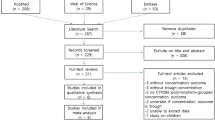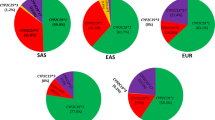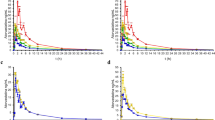Abstract
In bioequivalence studies, intra-individual variability (CVw) is critical in determining sample size. In particular, highly variable drugs may require enrolment of a greater number of subjects. We hypothesize that a strategy to reduce pharmacokinetic CVw, and hence sample size and costs, would be to include subjects with decreased metabolic enzyme capacity for the drug under study. Therefore, two mirtazapine studies, two-way, two-period crossover design (n=68) were re-analysed to calculate the total CVw and the CVws in three different CYP2D6 genotype groups (0, 1 and ⩾2 active genes). The results showed that a 29.2 or 15.3% sample size reduction would have been possible if the recruitment had been of individuals carrying just 0 or 0 plus 1 CYP2D6 active genes, due to the lower CVw. This suggests that there may be a role for pharmacogenetics in the design of bioequivalence studies to reduce sample size and costs, thus introducing a new paradigm for the biopharmaceutical evaluation of drug products.
This is a preview of subscription content, access via your institution
Access options
Subscribe to this journal
Receive 6 print issues and online access
$259.00 per year
only $43.17 per issue
Buy this article
- Purchase on Springer Link
- Instant access to full article PDF
Prices may be subject to local taxes which are calculated during checkout


Similar content being viewed by others
References
Davit BM, Conner DP, Fabian-Fritsch B, Haidar SH, Jiang X, Patel DT et al. Highly variable drugs: observations from bioequivalence data submitted to the FDA for new generic drug applications. AAPS J 2008; 10: 148–157.
Vaan Peer A . Variability and impact on design of bioequivalence studies. Basic Clin Pharmacol Toxicol 2010; 106: 146–153.
CYP2D6 allele Nomenclature. http://www.cypalleles.ki.se/cyp2d6.htm (Accessed 17 June 2011).
Llerena A, Cobaleda J, Martínez C, Benítez J . Interethnic differences in drug metabolism: influence of sex-related and environmental factors on debrisoquine hydroxylation phenotype. Eur J Drug Metab Pharmacokinet 1996; 21: 129–138.
Dorado P, Peñas-Lledó EM, Llerena A . CYP2D6 polymorphism: implications for antipsychotic drug response, schizophrenia and personality traits. Pharmacogenomics 2007; 8: 1597–1608.
Kirchheiner J, Henckel HB, Meineke I, Roots I, Brockmöller J . Impact of the CYP2D6 ultrarapid metabolizer genotype on mirtazapine pharmacokinetics and adverse events in healthy volunteers. J Clin Psychopharmacol 2004; 26: 647–652.
Timmer CJ, Sitsen JM, Delbressine LP . Clinical pharmacokinetics of mirtazapine. Clin Pharmacokinet 2000; 38: 461–474.
Yong Chung J, Jung Lee Y, Bok Jang S, Ahyoung Lim L, Soo Park M, Hwan Kim K . CYP3A5*3 genotype associated with intra-subject pharmacokinetic variation toward tacrolimus in bioequivalence study. Ther Drug Monit 2010; 32: 67–72.
Borobia AM, Novalbos J, Guerra-López P, López-Rodríguez R, Tabares B, Rodríguez V et al. Influence of sex and CYP2D6 genotype on mirtazapine disposition, evaluated in Spanish healthy volunteers. Pharmacol Res 2009; 59: 393–398.
Chen ML, Lee SC, Ng MJ, Schuirmann DJ, Lesko LJ, Williams RL . Pharmacokinetic analysis of bioequivalence trials: implications for sex-related issues in clinical pharmacology and biopharmaceutics. Clin Pharmacol Ther 2000; 68: 510–521.
LLerena A, Dorado P, Peñas-Lledó EM . Pharmacogenetics of debrisoquine and its use as a marker for CYP2D6 hydroxilation capacity. Pharmacogenomics 2009; 10: 17–28.
Acknowledgements
This work was partially supported by a scholarship of the National Agency for Research and Innovation of Uruguay, by the Instituto de Salud Carlos III, and EU FEDER Grants PI10/02758 and CP06/00030 (PD). The study was coordinated in the networks CIBERSAM and CAIBER, which are initiatives of ISCIII (Spain).
Author information
Authors and Affiliations
Corresponding author
Ethics declarations
Competing interests
The authors declare no conflict of interest.
PowerPoint slides
Rights and permissions
About this article
Cite this article
González-Vacarezza, N., Abad-Santos, F., Carcas-Sansuan, A. et al. Use of pharmacogenetics in bioequivalence studies to reduce sample size: an example with mirtazapine and CYP2D6. Pharmacogenomics J 13, 452–455 (2013). https://doi.org/10.1038/tpj.2012.29
Received:
Revised:
Accepted:
Published:
Issue Date:
DOI: https://doi.org/10.1038/tpj.2012.29



